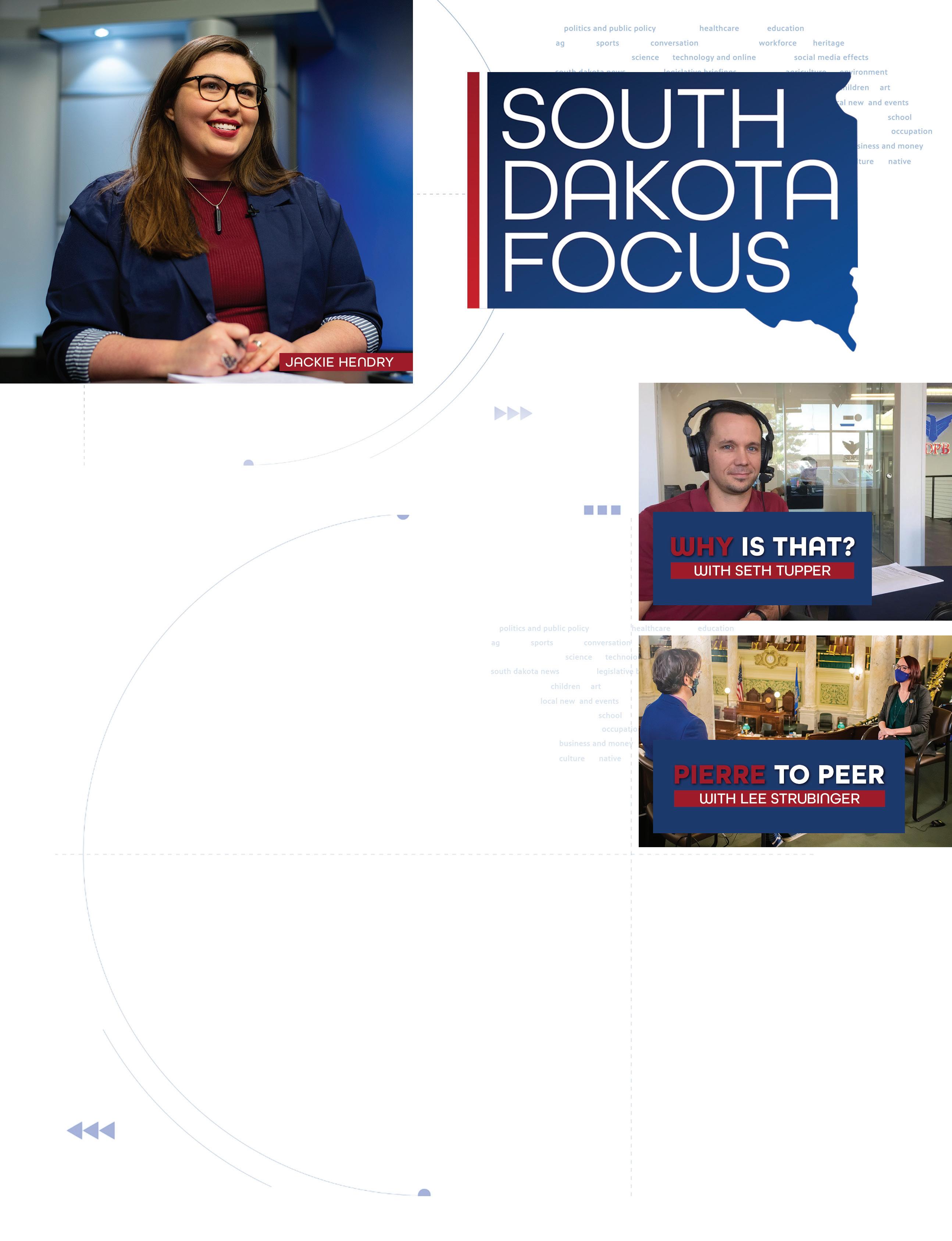
5 minute read
South Dakota Focus
by SDPB
For 26 years, South Dakota Focus has provided in-depth discussions with South Dakotans about issues and events impacting the state. As news cycles become more fast and furious, Focus provides just what the title connotes: an opportunity to take the time to see matters more clearly.
As the format of South Dakota Focus gets a freshening, host Jackie Hendry talks about the updates, including new segments and the civil, South Dakota-centered discourse viewers rely on.
Katy Beem: Tell us about the changes in format: topic selection, new segments, news headlines, and what the changes are meant to accomplish and convey to viewers.
Jackie Hendry: “One of the main goals is making the format more fast-paced while maintaining the same in-depth coverage of South Dakota issues people have come to expect. We’re still brainstorming the final format that will premiere this fall, but Statehouse coverage gives us a chance to experiment with segments and pacing. We still have a key topic (focus!) of the week, but rather than an hour of roundtable discussions on a single issue, we lead with a prerecorded feature to give audiences some introductory knowledge on the issue. Then we take a deeper dive with live conversations with guests who can give more detail. From there we move on—maybe to a relevant interview from Lori Walsh and In the Moment. Maybe to “Peer to Pierre,” Lee Strubinger’s first-hand Capitol conversations. Maybe to other headlines or historical context of current issues with Seth Tupper’s “Why Is That?” segment.
This approach is more timeconsuming and has more moving parts, but it’s been exciting. Viewer feedback I’ve received so far has been positive. I hope these changes continue to serve our viewers but help us reach a whole new audience that may not yet realize this program exists— which is the case, especially for many young adults I know. One uninterrupted hour to cover South Dakota stories is a magnificent opportunity. There are plenty of stories to tell. I’m excited to find new, creative ways to tell them.”
KB: You’ve got a couple shows under your belt. What have you learned?
I’m learning to craft an hourlong experience for viewers instead of a five-minute radio feature. For example: if my mind wanders while I’m reading the teleprompter, the headline segment is too long! It’s also intimidating—for the last three years I’ve focused on health and education. Those topics alone are quite broad, but now the doors are wide open. Our second show focused on agriculture and environmentalism—two topics I don’t know as much about, and I worried about my questions. But I chose that topic because it is so key to living in our state, and I wanted to rise to the challenge sooner rather than later.”
KB: What’s the process of researching and prepping for the show?
JH: “Each show starts with a lead-off feature and live guests. I’ve been approaching those topics and research like I approached reporting: I watch the headlines, skim legislative committee agendas and social media, see what’s getting people to ask questions or what’s raising my eyebrows. I run ideas past my team, then decide how to approach it: What’s the groundlevel information about this issue an unfamiliar audience needs to know? How do I set the stage for a broader conversation? I may already have potential guests in mind, or I’ll take to social media or get suggestions from my team. For the feature, I’ve been working with videographer Krystal Schoenbauer. Once I’ve written a script and gotten an edit, I may have suggestions for video she can put to the voice over—but so far, Krystal has done stupendous work bringing feature stories to life, and she’s a treat to work with.
Other segments like “Pierre to Peer” and “Why Is That?” are largely left to Lee and Seth, with some input. I trust their expertise, and the three of us and producer Josh Haiar often message throughout the week, bouncing ideas off of each other. It’s a great benefit that we’re so spread out: Lee in Pierre for the session, Seth based in Rapid City, and Josh and I in Sioux Falls. We each have different networks of contacts with different concerns and questions to address in the show.”
KB: What opportunities do you see for the program coming down the pipeline? As you get your sea legs, what’s on your wish list?
JH: “Outside of legislative session, exploring other recurring segments and deeper visual storytelling. There are plenty of subjects I covered as a reporter that I still want to cover: rural mental health resources, education innovations in Native communities, issues facing eldercare facilities, fallout from COVID. There are so many stories in Sioux Falls and Rapid City, but I also want to branch beyond those communities to find stories we’re missing—the quirky, the innovative, the human stories. I have ideas I’m keeping close to the chest right now because I want to focus on finessing the show’s format, but I absolutely want to spend more time in our more rural communities, finding under-covered stories throughout the state, strengthening and expanding relationships with Native neighbors, and expanding our reach to a wide variety of audiences. There is no other television program like this in South Dakota—one hour, uninterrupted by commercials, dedicated to telling statewide and uniquely South Dakota stories. I didn’t grow up here, but I chose South Dakota very purposefully because I’m in love with the stories and the people here. I’m nervous about what it means to be stepping into this much more visible role, but excited. When I came here as a college student, visual storytelling and documentaries rooted in this place were my dream. Now the dream has come true! So, what stories need telling? What can we dream up next?”








